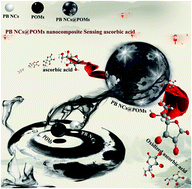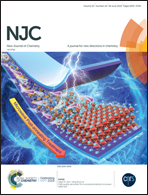Prussian blue nanocubes with an open framework structure coated with polyoxometalates as a highly sensitive platform for ascorbic acid detection in drinks/human urine†
Abstract
A sensitive non-enzymatic electrocatalyst based on a nanocomposite of Prussian blue nanocubes (PB NCs) coated with vanadium-substituted polyoxometalates (POMs) was reported in this work. The PB NC@POM nanocomposite was directly constructed using a self-assembly approach with the aid of poly(ethylenimine) (PEI), showing excellent electrocatalytic capacity toward ascorbic acid (AA) oxidation because of the synergistic effect of PB NCs and POMs. Additionally, the negatively charged POM anions can also serve as binding sites with high affinity to the open metal centers of PB NCs, reducing the diffusion of PB NCs out of the nanocomposite and improving the overall stability. The resulting PB NC@POM-based sensor exhibited outstanding sensing capability for AA, including a wide linear range of 7.50 × 10−7 to 4.10 × 10−4 M, and a low detection limit of 5.14 × 10−7 M (at S/N = 3), as well as good anti-interference and stability. Moreover, such excellent recoveries were obtained from the real sample experiments (in drinks/human urine), demonstrating that the PB NC@POM-based sensor was an excellent potential platform for the detection of ascorbic acid in practical applications.



 Please wait while we load your content...
Please wait while we load your content...